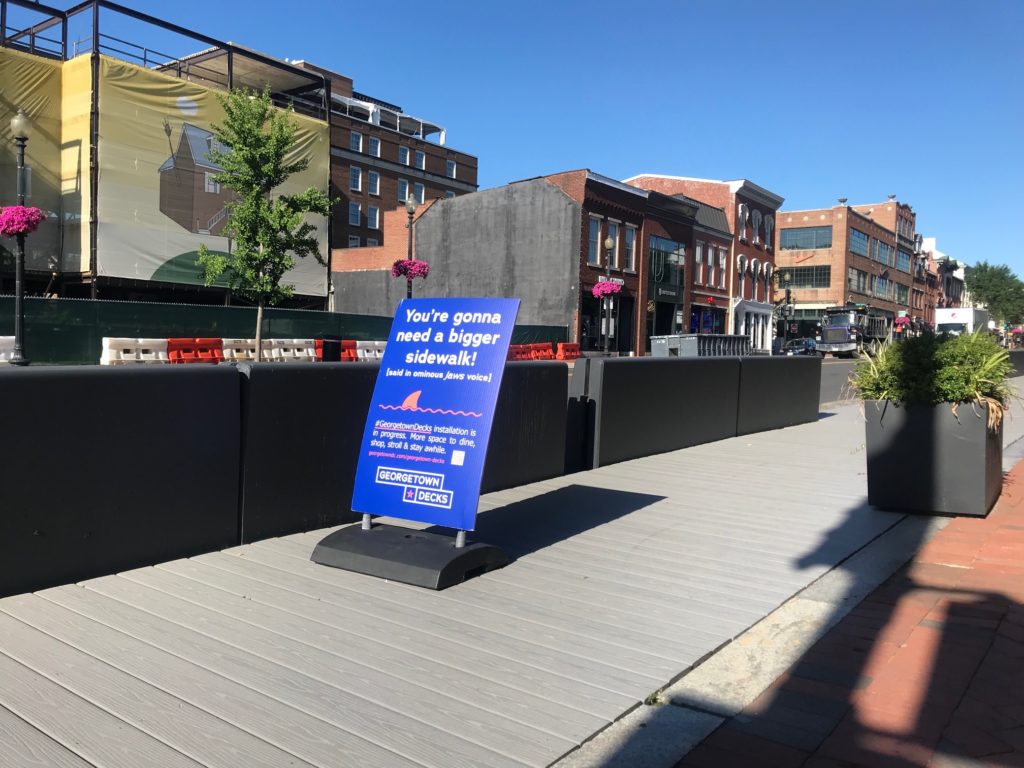Passionate Town Discussion Over Expanded Sidewalks
By • June 24, 2021 0 1218

The temporary Georgetown project to lay out some 3500 linear square feet of expanded sidewalks — specially constructed curb fitting platforms, traffic protectors and landscaping — on both sides of Georgetown’s main commercial streets, M St. and Wisconsin Ave. from the waterfront to R St. NW, is expected to be completed by July 1. Already Georgetown residents are sounding off.
The project permits expire on December 31 and the process of evaluation is beginning, reported officials from the Georgetown Business Improvement District (BID), the project’s coordinating organization, at two virtual town discussions on June 21 and 22. Now begins a six-month period of usage and assessment to determine the impact of the expanded sidewalks on stimulating Georgetown commerce, and the project’s effects on the lives of residents, visitors, and tourists.
Various kinds of data and assessment tools will be used continually to evaluate the project’s impact over the next six months. These include pedestrian and visitor counts, feedback from businesses, visitors, residents; data from credit cards; parking citations and other law enforcement information; and observations of parking availability and double parking. Almost all of those trigger points and more were mentioned by the participants in the virtual town discussion sessions, which drew well over 100 viewers.
Those who called in and spoke out were a good mix of residents and former Georgetown leaders such as former long-term Georgetown/Burleith Advisory Neighborhood Commissioners Tom Birch, Ron Lewis, Bill Starrels and Monica Roaché. Expanding the sidewalks has been a big issue in Georgetown for decades and most engaged Georgetowners have been involved for years on the issue and its biggest challenge: PARKING.
Most of the spoken comments were critical of the project. “But results coming in from a survey sent out online have been almost equally balanced between likes and dislikes,” BID Director of Planning and Economic Development, Jamie Scott, told The Georgetowner on June 23. Many of the comments during the virtual discussions seemed to make a distinction between use of the expanded sidewalks for streateries (generally supported) vs. use by retail (generally not supported) vs. long stretches of unused (to date) raised sidewalks (often dismissive).
Many of the comments were direct. “Widening sidewalks is a big mistake,” said Lewis, a former ANC chairman. “Georgetown leaders must examine this very carefully.”
“Now that social distancing is no longer required, there is no need for long stretches of expanded sidewalks,” said Starrels.
“I don’t feel safe eating in the streateries with cars going by so close,” said Roaché. “And I don’t see people using the expanded sidewalks. What saddens me is we have lost the beauty.”
There was apparent consensus that the expanded sidewalks — which take up some 200 parking places — have pushed parking and traffic onto the nearby residential areas, as well as caused some bad behavior. “Night time parking and behavior is different from daytime. I’ve seen it on my street,” said Birch who lives on Olive and 29th Sts., in response to several residents’ comments about seeing drunkenness and people urinating in front residential gardens and leaving trash at night. “While we are an urban community, still we don’t need wider sidewalks to take up parking spaces on the commercial streets,” said Birch. “Take down the sandwich boards, restrict streateries to the width of the restaurant and cafes’ front footprint and get rid of the rest of the platforms to bring back parking nearer the dining establishments,” Birch suggested. “It all has to be flexible.”
Other participants also urged such flexibility. The platforms can be interspersed with street parking. Several commentators pointed out the need for real time cost-benefit analysis.
Scott agreed. “We don’t have to wait until December to make changes when it comes to parking vs. expanded sidewalks,” he said repeatedly. “The design of the project is intended to allow modifications during the course of the pilot. While the permit for everything is valid through December, we can make changes before then, as necessary.”
“Seventeen different agencies were needed to sign off on the pilot project, yet the current configuration is not the final nor even the optimal one,” Scott concluded. “In the end it may be that the community decides they want expanded sidewalks only for eating establishments –- streateries. Or have only seasonal sections of expanded sidewalks, or have some blocks with widened sidewalks partially for streateries and some for retail. Or none of the above.”
The Sidewalk Widening Project Survey is accessible on the BID website (georgetowndc.com) until July 1. Scott’s email is jscott@georgetowndc.com The next town discussion will be September 20 and 21.

